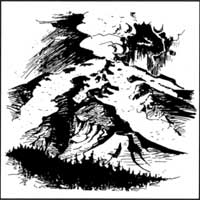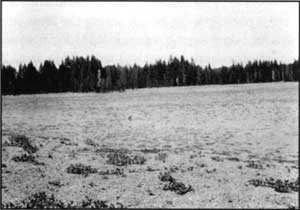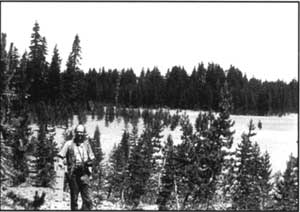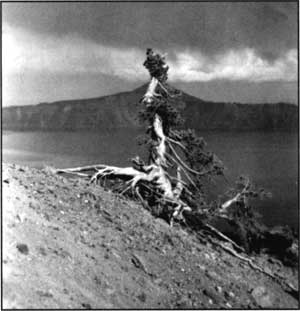Pumice Fields and a Sense of Landscape Wonder
Coniferous forest which surrounds the caldera embracing Crater Lake is broken by curious openings called pumice fields, especially around the rim. Many of the pumice fields are spacious and provide grand vistas of the Cascade Range, but they are also windows into the landscape’s past. The climactic eruption 7,700 years ago instantly erased biota firmly rooted upon the slopes of ancient Mount Mazama. Pioneering lifeforms of the pre-Mazama biota surviving in neighboring refugia eventually migrated upslope and colonized suitable habitats, but the eruption’s power restricted the availability of these habitats.
 Hypothesized appearance of Mazama at the beginning of its climactic eruption. Drawing by Walter Rives, 1948. |
Despite dry and sunny summer weather enjoyed by human visitors, the growing season of the pumice fields is abbreviated by extremes of temperature and moisture. Topographic features create frost pockets in swales, along lower slopes, and in crater depressions atop cinder cones. This allows snow to drift and accumulate, so that it sometimes persists through the growing season. Upland habitats, especially those with rocky outcrops, are devoid of snowpack early in the summer but are subject to dry winds — as are south- and west-facing slopes. Surface temperatures are normally intensified by high summer sun, but reduced by reflective qualities of the light-colored pumice. Air temperatures near the ground may change significantly over a 24 hour period, with a chance for frost even in summer. Pumice soils, having been pulverized by volcanic eruption, are very porous. This allows large quantities of water to infiltrate and percolate deeply, but largely robs the surface of moisture.
The volcanic landscape of Mount Mazama represents a mosaic of habitat types, and the pumice fields have resisted encroachment by individual trees and shrubs for centuries. The tree species best suited for pioneering this seemingly inhospitable habitat appears to be whitebark pine (Pinus albicaulis). This species even assumes the role of pioneer in the fractured obsidian flow of Paulina Peak at Newberry Caldera southeast of Bend. Similarly, much of the caldera’s rim edge around Crater Lake is fringed with whitebark pine as though planted in a row single file. It is this edge habitat, which is swept free of deep snow, that harbors a longer growing season than adjacent pumice fields extending downslope from the rim. This is also where the Clark’s nutcracker (Nucifraga columbiana) caches seeds from whitebark pines, thereby insuring some regeneration.
 There are some “tree islands” within the pumice fields generally featuring a single whitebark pine perhaps established a few centuries earlier. These trees may be situated on churned soil where a Mazama pocket gopher, Thomoys mazama, created a mound within the shelter of a rock. During the growth of a “mother tree,” local microclimate changes to favor the establishment of herbaceous and shrub species in addition to subalpine fir (Abies lasiocarpa) or mountain hemlock (Tsuga mertensiana) sheltered by the whitebark’s canopy. It is common to find that the original “mother tree” has died, but still is surrounded by younger trees which prevent the snag from falling. In an environment marked by harsh growing conditions, chances for survival are enhanced by development of individual saplings in aggregations or clumps with grafted roots.1
There are some “tree islands” within the pumice fields generally featuring a single whitebark pine perhaps established a few centuries earlier. These trees may be situated on churned soil where a Mazama pocket gopher, Thomoys mazama, created a mound within the shelter of a rock. During the growth of a “mother tree,” local microclimate changes to favor the establishment of herbaceous and shrub species in addition to subalpine fir (Abies lasiocarpa) or mountain hemlock (Tsuga mertensiana) sheltered by the whitebark’s canopy. It is common to find that the original “mother tree” has died, but still is surrounded by younger trees which prevent the snag from falling. In an environment marked by harsh growing conditions, chances for survival are enhanced by development of individual saplings in aggregations or clumps with grafted roots.1
A pumice field near Union Peak in 1936 (top) and forty years later (bottom). Photos by Homer Marion, 1936 (top) and Ron Mastrogiuseppe (bottom).
Given the potential number of species available for colonizing pumice fields, however, it is a mystery why additional lifeforms have not yet invaded. Each year, and especially when there is a prolific seed cone crop, the pumice fields are recipients of myriad seeds and propagules. Yet this annual “rain” of seed seems unable to bring additional numbers of species. The total number of plant species found within the Pumice Desert, for example, is only fourteen.2 Other pumice fields are likely similar in species diversity. When compared to the park total of some 700, this gives meaning to the term depauperate flora — one lacking in species richness.
The shape of pumice fields can change over time when surrounding forest borders (usually dominated by lodgepole pine, Pinus contorta) respond to favorable conditions. Conifer encroachment, as documented in repeat photography, began during the drought episode of the 1930s. During that decade growing seasons expanded by roughly one month as the result of warmer temperatures and reduced snowpack.3 This pattern of encroachment is not unique to the Crater Lake region, having been observed throughout the subalpine zone of the Cascade Range. Perhaps similar phenomena will be kickstarted by the years of drought (which extended from 1976-77 until the early 1990s) since these changes are believed to be driven by climatic, rather than climactic,events.

Whitebark pine on the rim of Crater Lake.
Notes
1 Fire seems to have little effect on this habitat. Lightning may strike individual stems within the tree islands, but fuels beyond them are too scant to carry a surface fire for any distance. It should not be a surprise, then, that evidence of historic fire is almost always absent from pumice fields.
2 See Ruth Monical and Stephen P. Cross. Mammals of the Pumice Desert, Nature Notes from Crater Lake 23 (1992). pp. 17-18.
3 The exception to this interpretation was the winter of 1932-33, when a record of more than 700 inches occurred.
Ron Mastrogiuseppe is a forest ecologist who has monitored pumice fields and other phenomena in Crater Lake National Park since 1964.
Other pages in this section

